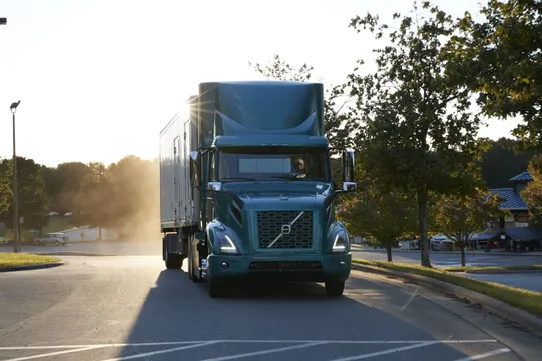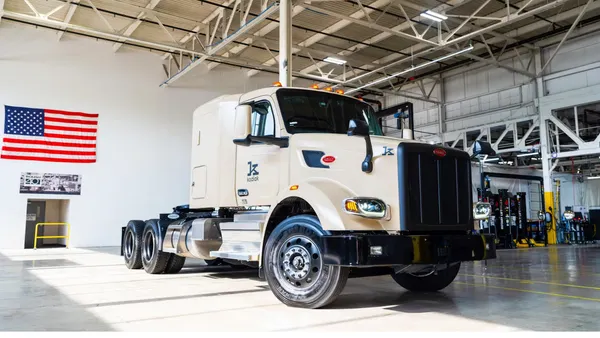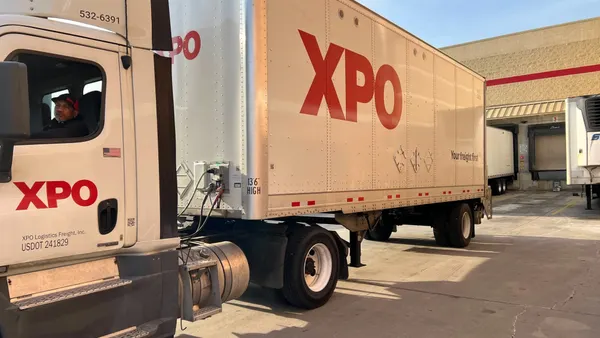Brokers, once blamed for plummeting TL spot rates in the spring of 2020, are now living in a carrier’s market.
The elevated TL spot rates have kept carriers busy and paid. The capacity crunch means brokers have to scramble harder to get shippers the seated trucks they need.
It’s a huge reversal of fortune for brokers, who were said to have all the power in the TL spot world in the spring of 2020. At the time, brokers were seen as being in the driver’s seat. Brokers dispute some of that take — they note declining volumes hurt them too — and say they had to hustle to keep the drivers coming back. That means tending to relationships and adding technologies to make transactions smooth and convenient.
“It has heightened the focus on trust and relationships,” said Justin Frees, chief capacity officer of Arrive Logistics. “If [carriers] don’t trust you, they will go elsewhere.”
That dynamic has 3PLs such as Arrive Logistics eyeing changes in how they communicate with shippers and carriers.
This spring, Arrive Logistics added a partnership with TriumphPay to make payments to carriers faster and more visible. The company also built an internet portal to allow carriers access to freight around the clock. The portal, called Carrier Edge, allows booking or offers. Frees said the portal was important because some carriers don’t mind conducting 100% of their business online.
Frees said one thing Arrive Logistics does to maintain relationships is “exception management,” the management of problems that pop up on the road. Frees said it’s easy to maintain good relationships when every lane sees perfect performance, “but things happen out there on the road.”
“We take that head on,” said Frees.
From the doldrums of spring 2020
The cause of the tightness in capacity — a short supply of seated trucks — has analysts abuzz. Some predict rates have hit their top. Shippers are adjusting and more trucks are pulled back onto the road, attracted by higher rates.
Those rates have caused requests for authority from the FMCSA to boom in 2020 and into 2021, resulting in 58,000 new carrier groups last year, according to Avery Vise, vice president of trucking for FTR. That was a 36% jump from 2019.
Others speculate and perhaps fret the new supply of drivers is not enough.
“Supply side constraints continue to be an issue,” one TL broker told Morgan Stanley. “The biggest question is whether drivers are staying away from the road due to government aid or if they’re just gone and never coming back. Should know for sure once we get into Q3.”
Brokers say the competitive environment is not new. But it’s a far cry from the onset of the COVID-19 pandemic in the spring of 2020. With schools, some factories and restaurants closed — but the number of truckers on the road largely unchanged — posted dry van loads disappeared by two-thirds in April 2020, according to numbers from the Transportation Intermediaries Association. The TIA also noted then that shipper offer rates dropped from $1.60 per mile to $1.10 per mile, on average, nationwide.
Many of the nation’s 200,000 independent carriers decided to park instead of roll. The Owner-Operator Independent Drivers Association and others blamed brokers for the situation.
Some parked near the White House and Capitol. They honked their horns in protest when former President Donald Trump was in the Rose Garden on May 15, 2020.

Days later, at a public meeting with U.S. Labor Secretary Eugene Scalia, Trump urged federal action on the transparency of offered rates.
“And Gene, you have to help the truckers, also,” Trump said. “They work hard and they have brokers that take a lot of their business away. [Brokers] don’t work so hard. [Brokers] sit in an office some place. It’s not good. So I’d like to help the truckers.”
OOIDA had asked for the reform before, in other down markets such as 2005 and 2010. Much of the information OOIDA wants it gets, because of a federal law telling brokers to keep records of each transaction. The records must be presented to carriers upon request. The records contain:
- The name and address of the consignor.
- The name, address and registration number of the originating motor carrier.
- The bill of lading or freight bill number.
- The amount of compensation received by the broker for the brokerage service performed and the name of the payer.
- A description of any non-brokerage service performed in connection with each shipment or other activity, the amount of compensation received for the service, and the name of the payer.
- The amount of any freight charges collected by the broker and the date of payment to the carrier.
But what OOIDA wanted was for shippers to be prevented from asking for confidentiality clauses in contracts with the brokers. TIA instructed brokers to tell carriers that, if they obtain records, it would disqualify them from getting loads from any shippers with confidentiality clauses. TIA said if shippers didn’t get confidentiality from drivers, shippers would form their own fleets to protect competitive information.
A tight market, once again
Today, with elevated TL spot rates having lasted for months, and with Truckstop.com predicting they will last through the year, Congress has signaled to TIA they have moved on.
“That issue has completely died down,” said Chris Burroughs, TIA VP of government affairs. “The market has completely shifted.”
Now, Burroughs said, rates have rebounded and volumes are rising, which benefits brokers and truckers alike. But capacity is an issue, and that has given drivers the advantage in the rebounding.
Brent Hutto, chief relationship officer of Truckstop.com, said his company does business with 10,000 brokerage units, ranging from asset-light companies to big fleets looking to “release the pressure” by going to in-house brokers in case they overbook.
Spot rates rebound after spring 2020 lows
Hutto said the elevated TL spot market should indicate to fleet executives that it’s good time to be both a carrier and a broker, because a fleet can advertise it has more capacity than posted, and it doesn’t have to buy trucks to expand that capacity. Instead, it can farm out the excess to independent drivers.
Hutto said truckers can look elsewhere for better rates, a big change from spring of 2020. So what is a broker to do? It all comes back to basic market economics.
“Negotiate the best agreeable rate for the carrier to move the load,” said Hutto.
Hutto said many brokers are going back to shippers and renegotiaing transportation prices, a “normal” process in any market cycle. But he notes this market cycle itself, and the elevated TL rates, are something to behold.
“It’s never been this high, ever in the history of trucking, since deregulation,” said Hutto. “We have had three capacity crises in the last six years.”














